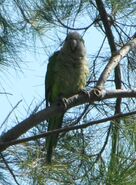| Monk Parakeet | |
|---|---|
 | |
| Scientific classification | |
| Kingdom: | Animalia |
| Phylum: | Chordata |
| Class: | Aves |
| Order: | Psittaciformes |
| Family: | Psittacidae |
| Genus: | Myiopsitta |
| Species: | Myiopsitta monachus |
The Monk Parakeet (Myiopsitta monachus), also known as the Quaker Parrot, is a small-medium sized parrot in the family Psittacidae.
Taxonomy[]
The Monk Parakeet is generally considered the only member of the genus Myiopsitta. It has four subspecies:
- M. m. monachus, the nominate subspecies;
- M. m. calita, which has less grey on its forehead and darker blue wing feathers;
- M. m. cotorra, similar to the previous subspecies but with a belly of a paler yellow;
- M. m. luchsi, by some considered a distinct species known as the Cliff Parakeet, smaller in size and with a conspicuous yellowish bar on its chest.
Description[]
The Monk Parakeet is a 29 cm (11.4 in) long parrot with a wingspan of about 48 cm (18.9 in) and a relatively long tail. It is mostly bright green with pale grey cheeks, forehead and chest, a pale yellowish-green belly, and blue remiges and tail feathers. Its bill is orange, its eyes black and its legs gray. The sexes are alike.
Behavior[]

Four Monk Parakeets foraging together on a football field.
A gregarious bird, the Monk Parakeet forms noisy flocks of up to 100 individuals that travel together in search of food. It is a resident.
Feeding[]
Its diet includes the seeds of thistle, weeds and trees, fruit, berries, flowers, and, occasionally, larvae and insects.
Breeding[]

A couple of Monk Parakeets.
The breeding season begins around the month of October. Monk Parakeets build large colonial nests on tall trees, up to 20 m high. The average nest hosts 10-20 couples and may weigh up to 200 kg. Each couple has its own nesting chamber, where the female lays 5-8 eggs. The eggs are incubated for about 20 days, and the young fledge within 6 weeks from hatching. In a particularly favorable year, a pair may raise two broods.
Distribution and habitat[]
The Monk Parakeet is native to a vast portion of southeastern South America, which includes Argentina, Paraguay, Uruguay, Bolivia and Brazil, where, despite being hunted for being a crop pest, it is still very common. Like the Rose-ringed Parakeet, the Monk Parakeet has successfully settled in areas outside of its natural range. Large colonies of feral Monk Parakeets are found in cities across the US and Europe, such as New York and Madrid. This parrot typically inhabits open woodlands, gallery forests, acacia thickets and savannas. Though it is usually not found above 1000 m of altitude, it adapts well to higher altitudes, so much so that M. m. luchsi has been sighted at up to 3000 m.
In captivity[]

A pet Monk Parakeet.
The Monk Parakeet is very common and easily bred in captivity, and makes a docile and playful, albeit noisy, pet. It comes in various mutations, including blue and lutino.





